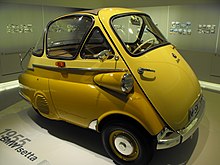BMW AG originated with three other manufacturing companies, Rapp Motorenwerke and Bayerische Flugzeugwerke (BFw) in Bavaria, and Fahrzeugfabrik Eisenach in Thuringia. Aircraft engine manufacturer Rapp Motorenwerke became Bayerische Motorenwerke in 1916 when the board of directors fired founder Karl Rapp and changed the company name. The engine manufacturer, which built proprietary industrial engines after World War I, was then bought by the owner of BFw who then merged BFw into BMW and moved the engine works onto BFw's premises. BFw's motorcycle sideline was improved upon by BMW and became an integral part of their business.
BMW became an automobile manufacturer in 1929 when it purchased Fahrzeugfabrik Eisenach, which, at the time, built Austin Sevens under licence under the Dixi marque. BMW's team of engineers progressively developed their cars from small Seven-based cars into six-cylinder luxury cars and, in 1936, began production of the BMW 328 sports car. Aircraft engines, motorcycles, and automobiles would be BMW's main products until World War II. During the war, against the wishes of its director Franz Josef Popp, BMW concentrated on aircraft engine production, with motorcycles as a side line and automobile manufacture stopped altogether.
After the war, BMW survived by making pots, pans, and bicycles until 1948, when it restarted motorcycle production. Meanwhile, BMW's factory in Eisenach fell in the Soviet occupation zone and the Soviets restarted production of pre-war BMW motorcycles and automobiles there. This continued until 1955, after which they concentrated on cars based on pre-war DKW designs. BMW began building cars in Bavaria in 1952 with the BMW 501 luxury saloon. Sales of their luxury saloons were too small to be profitable, so BMW supplemented this with building Isettas under licence. Slow sales of luxury cars and small profit margins from microcars caused the BMW board to consider selling the operation to Daimler-Benz. However, Herbert Quandt was convinced to purchase a controlling interest in BMW and to invest in its future.
Quandt's investment, along with profits from the BMW 700, brought about the BMW New Class and BMW New Six. These new products, along with the absorption of Hans Glas GmbH, gave BMW a sure footing on which to expand. BMW grew in strength, eventually acquiring the Rover Group (most of which was later divested), and the license to build automobiles under the Rolls-Royce marque.
In This Page we are sharing about the cars from 50s to 80s.
BMW Isetta
he Isetta is Italian-designed microcar built in a number of different countries, including Spain, Belgium, France, Brazil, Germany, and the United Kingdom. Produced in the post-World War II years, a time when cheap short-distance transportation was most needed, it became one of the most successful and influential city cars ever created. Because of its egg shape and bubble-like windows, it became known as a bubble car, a name later given to other similar vehicles, including the AMC Pacer.
The BMW Isetta was in 1955 the world's first mass-production 3-liter car. Its low-friction 1-cylinder engine and low weight gave it a fuel efficiency of 3.3 litres per 100 kilometres (86 mpg-imp; 71 mpg-US) (manufacturer information). It is the top-selling one cylinder car in the world, with 161,728 units sold.[1]
There are 3 Types of Isetta were Manufactured by BMW
- BMW 250 (Isetta) 1955- 1962
- BMW 300 (Isetta) 1955- 1962
- BMW 600 1957- 1959
BMW 250
While it retained the "Bubble Window" styling, it differed from the Italian model in that its headlamps were fixed separately to the sides of the bodywork and it carried the BMW badge below the windscreen. The car was also redesigned to take a modified version of the 250 cc four-stroke engine from the BMW R25/3 motorcycle and the front suspension was changed. The single-cylinder generated 9 kW (12 hp) at 5800 rpm. The crankcase and cylinder were made of cast iron, the cylinder head of aluminium. However, the head was rotated by 180° compared with the motorcycle engine. The twin-bearing crankshaft was also different in the Isetta power unit, being larger and featuring reinforced bearings. One of the reasons for this was the heavy Dynastart unit which combined the dynamo and self-starter. The fuel mixture was provided by a Bing sliding throttle side draft motorcycle carburetor. In addition to further changes of detail, the BMW engineers enlarged the sump for installation in the car and cooled the engine by means of a radial fan and shrouded ducting.
BMW 300
BMW made the Isetta its own. They redesigned the powerplant around a BMW one-cylinder, four-stroke, 247 cc motorcycle engine which generated 10 kW (13 hp). Although the major elements of the Italian design remained intact, BMW re-engineered much of the car, so much so that none of the parts between a BMW Isetta Moto Coupe and an Iso Isetta are interchangeable. The first BMW Isetta appeared in April 1955.
In May 1962, three years after launching the conventionally modern-looking BMW 700, BMW ceased production of Isettas. A total of 161,728 units had been built.
BMW 600
| Production | 1957–1959 34,813 built[1] |
|---|---|
| Predecessor | BMW 3/20 |
| Successor | BMW 700 |
| Layout | RR layout |
| Engine(s) | 582 cc flat twin |
| Transmission(s) | 4-speed manual all-synchromesh[2] |
| Wheelbase | 1,700 mm (67 in) |
| Length | 2,900 mm (110 in) |
| Width | 1,400 mm (55 in) |
| Height | 1,375 mm (54.1 in) |
| Curb weight | 515 kg (1,140 lb) dry weight |
| Related | BMW Isetta |
| Designer | Willy Black [3] |


